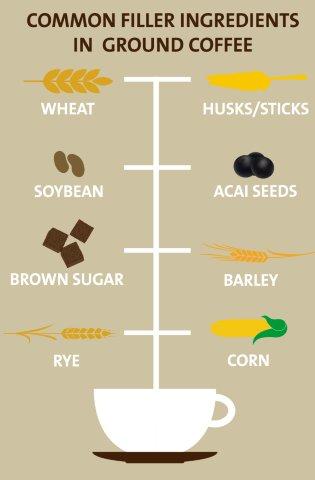FOR IMMEDIATE RELEASE | August 11, 2014
Keeping filler ingredients out of your cup of coffee
Note to journalists: Please report that this research will be presented at a meeting of the American Chemical Society.
Clarification: The research discussed in this press release focused only on ground, roasted coffee available in Brazil. The use of commercial coffee from Brazil allowed the researchers to develop and perfect chromatographic methodologies for detecting several filler ingredients common to tested coffee. The resulting methodologies will allow for testing of coffee from any market. Until such testing is done, the results of this research cannot be extrapolated to the U.S. or any other country. The National Coffee Association, USA has issued a statement (PDF) regarding its efforts to ensure that coffee is not adulterated.
SAN FRANCISCO, Aug. 11, 2014 — Coffee drinkers beware: Surprise ingredients that are neither sweet nor flavorful may be hiding in your coffee, and growing coffee shortages may increase the chance of having these fillers in your cup of joe in the future. The good news is that a highly accurate test is in the works to quickly find coffee containing unwanted fillers before the beverage reaches stores and restaurants.
These extra ingredients, though not harmful, make ground coffee go farther and increase profits for producers, according to researchers. Their report will be part of the 248th National Meeting & Exposition of the American Chemical Society (ACS), the world’s largest scientific society. The meeting features nearly 12,000 reports and is being held here through Thursday.
A test to detect counterfeit coffees is becoming more important in light of growing shortages in regions, such as Brazil, where droughts and plant diseases have dramatically cut back coffee supplies. “With a lower supply of coffee in the market, prices rise, and that favors fraud because of the economic gain,” says research team leader Suzana Lucy Nixdorf, Ph.D.
In 2012, a study from the U.K.’s Royal Botanic Gardens and the Environment stated that 70 percent of the world’s coffee supply might disappear by 2080 because of conditions caused by climate change. But shortages due to more immediate issues already are occurring. The coffee-rich country of Brazil typically produces 55 million bags of coffee each year. But according to some reports, the projected amount for 2014 will likely only reach 45 million bags after this January’s extensive drought. That’s about 42 billion fewer cups of coffee for this year.
Now, however, Nixdorf and her team at State University of Londrina in Brazil have developed a way to nip coffee counterfeiting in the bud.
“With our test, it is now possible to know with 95 percent accuracy if coffee is pure or has been tampered with, either with corn, barley, wheat, soybeans, rice, beans, acai seed, brown sugar or starch syrup,” she says. The problem, she explains, is that “after roasting and grinding the raw material, it becomes impossible to see any difference between grains of lower cost incorporated into the coffee, especially because of the dark color and oily texture of coffee.”
In new research, the team is now analyzing several fillers that are considered impurities rather than adulterants. These impurities can even be parts of the coffee plants, introduced at harvest, that are not really supposed to be in the final product. Wood, twigs, sticks, parchment, husks, whole coffee berries or even clumps of earth that are almost the same color as coffee have been found. Identifying them is essential because if there is a large amount of impurities, they were probably added purposefully — not by accident, as some producers claim, says Nixdorf.
Currently, tests to detect these unwanted additives require scientists to check the coffee, and those tests are subjective –– not quantitative, she says. With these tests, the scientists look at the coffee under a microscope or identify various additives by simply tasting the coffee. In contrast, the new test uses liquid chromatography and statistical tools. This gives her team a much closer look at the ingredients in an unbiased way, according to Nixdorf. Chromatography is a powerful analytical technique that is very sensitive and highly selective.
Because much of the coffee is composed of carbohydrates, researchers could develop a “characteristic fingerprint” when using chromatography that separates out the real coffee compounds, says Nixdorf. The added, unwanted grain fillers generate different levels of sugars than the natural ingredients, so they are easy to identify, she explains.
Nixdorf acknowledges funding from the Government of Brazil’s Coordenação de Aperfeiçoamento de Pessoal de Nível Superior, Conselho Nacional de Desenvolvimento Científico e Tecnológico, Financiadora de Estudos e Projetos and Fundação Araucária- Apoio ao Desenvolvimento Científico e Tecnológico do Paraná Productivity Scholarship.
The American Chemical Society is a nonprofit organization chartered by the U.S. Congress. With more than 161,000 members, ACS is the world’s largest scientific society and a global leader in providing access to chemistry-related research through its multiple databases, peer-reviewed journals and scientific conferences. Its main offices are in Washington, D.C., and Columbus, Ohio.
Media Contact
During the meeting, Aug. 9-13, the contacts may be reached at the S.F. Press Center: 415-978-3506.
ACS Newsroom
newsroom@acs.org

High-resolution image





